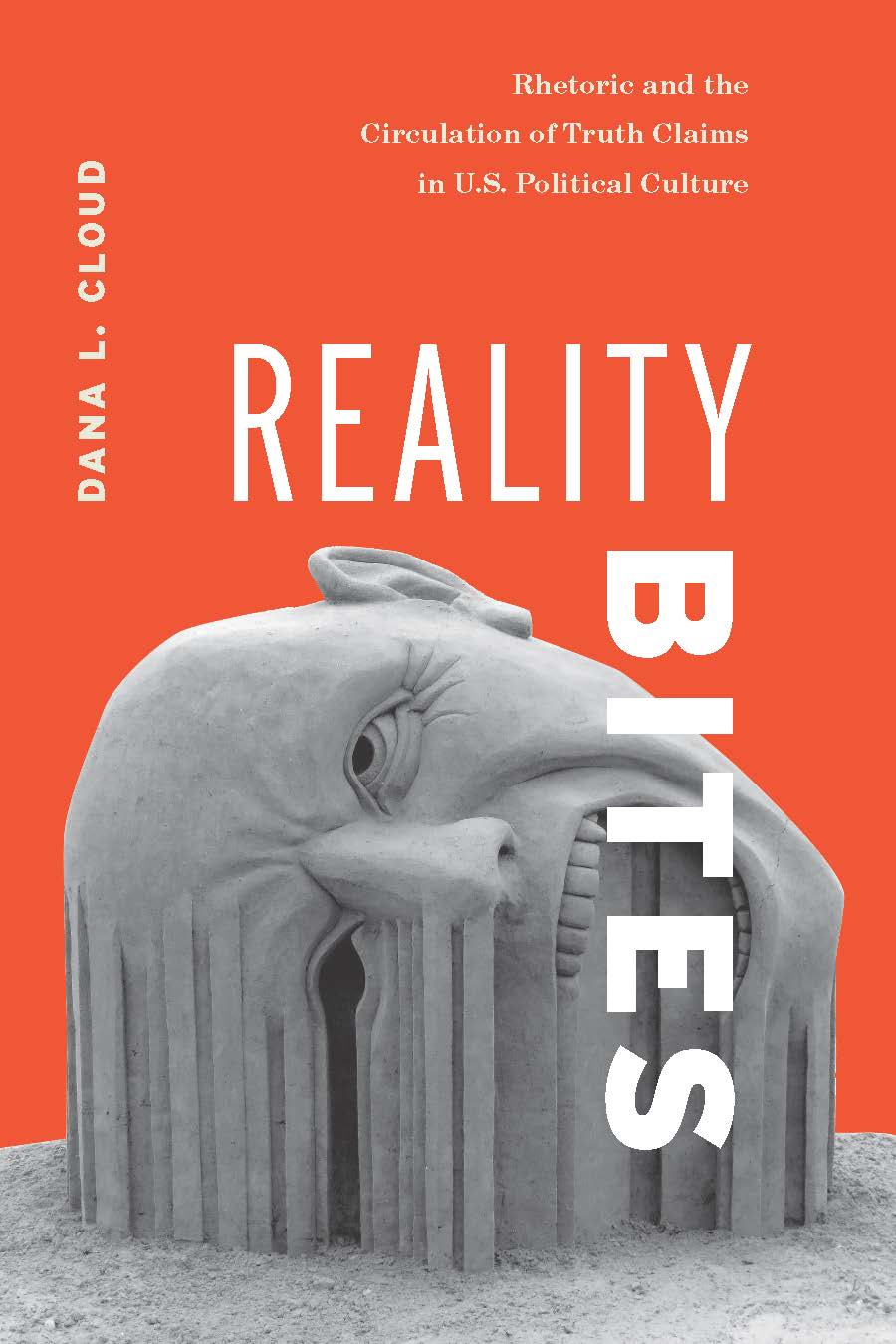Book Review: Cloud’s Reality Bites: Rhetoric and the Circulation of Truth Claims in U.S. Political Culture
Cloud, Dana. Reality Bites: Rhetoric and the Circulation of Truth Claims in U.S. Political Culture. Ohio State UP, 2018.

As a nation, the US is obsessed with facts. Punch the terms “Trump” and “fact check” into any search engine, and you will discover a litany of websites and articles annotating the misinformation circulated by the President over the years. Individuals, regardless of their political affiliation, commonly adhere to the belief that sifting through false information to get to the objective, unbiased “truth” is essential to public and political discourse. This perspective makes sense; what better evidence is there to help one win an argument than the cold, hard facts? However, as Dana Cloud argues in her 2018 book Reality Bites, the position of truth claims in contemporary US political culture is far more complicated.
In the introduction and chapter one, Cloud meticulously articulates a problem currently plaguing political discourse in the US. The American people, especially progressives and activists, are limited in their understanding and utilization of rhetorical strategies by clinging to truth-based claims and relying “too heavily and uncritically upon facts: observations, examples, statistics, transcripts of historical events, and so on” (3); however, a bigger fundamental flaw Cloud identifies is the misconceptualization of an objective truth or reality that can be accurately represented by so-called facts. Cloud, instead, argues that “there is no single ahistorical truth but rather dialectically evolving systems of ideas and regimes of knowledge” (7), the overarching idea she establishes early and revisits throughout her book. In other words, the notion of an objective reality is unattainable, as our experiences are constantly shaped and reshaped by any number of social conditions.
As a possible solution to this problem, Cloud advocates for the public to embrace a “rhetorical realism,” or the idea that “we can evaluate truth claims in public culture on the basis of whether they exhibit fidelity to the experience and interest of the people they claim to describe and represent” (15). That is, a rhetorical realism encourages individuals to examine the facts circulating in the public sphere and to ask themselves: What is the knowledge or information being presented, how is it being framed, who is doing the framing, and who benefits from having information portrayed in this way? In recognizing that truth can vary depending on a person’s perspective and/or position of power, we begin moving away from the limited evaluation of facts as true or false and instead focus on “whether a claim or set of claims represents the interests of the groups being asked to believe it” (33). Building off of poststructural and postmodern scholarship, Cloud suggests that such an approach is especially important for marginalized communities and counterpublics in order to amplify their voices and incorporate their experiences into the public consciousness: “I ask the question: how might ordinary people who suffer oppression and exploitation make those realities intelligible in common sense?” (29). Cloud concludes chapter one by directing her attention toward mediation as a rhetorical tool and its importance in influencing what the public perceives as truth. Defined as the practice of taking expert knowledge and translating it into a digestible form, mediation is “what takes ‘facts’ and turns them into beliefs and, ultimately, common sense” (2). More importantly, mediation is never neutral but rather a strategic process; therefore, mediators (e.g., political parties, media) play a pivotal role in facilitating how knowledge is taken up and should be subject to analysis and scrutiny, just like the facts they circulate.
Chapter two introduces five methods of mediation that Cloud sees frequently used in US political discourse: narrative, myth, affect, embodiment, and spectacle. According to Cloud, these methods are especially popular with conservatives and the ruling class, yet underutilized by the Left. What is particularly helpful in this chapter is Cloud’s balance between theory and example; her breakdown of each method is reinforced with a literature review as well as a demonstration of the method in action. For example, in her section on narrative and myth, Cloud unpacks Beyonce’s song “Formation,” discussing the social issues referenced in the lyrics, music video, and its performance at the 2016 Super Bowl halftime. By citing audience reactions from pro-police supporters, scholars, and the Black community, Cloud attempts to show how a narrative that incites contrasting responses can be considered disjointed yet still resonate with multiple audiences and deemed an accurate representation of their lived realities. The chapter concludes with a plea to the Left to recognize mediation as a rhetorical tool: “Opponents of the status quo cannot afford to dismiss these tools. To do so is elitist and self-defeating” (50). Instead of limiting political discourse to “just the facts,” Cloud urges readers to engage such mediation methods in the future and evaluate how they may be used to perpetuate acts of hegemony or sweep away larger social issues. Only then can the Left participate effectively in the political arena.
Chapter three continues to explore the effectiveness of fact-checking by concentrating on a scandal involving Planned Parenthood and other abortion clinics. While contemporary audiences have access to more information than at any other time in history, attempting to make sense of the content can be disorienting; fact-checking and deciphering truth from misinformation “is not a simple task, as both truth and falsehood are complex and multidimensional” (56). Cloud makes her stance on fact-checking clear when she calls it an “ideological distraction” (74) that leads the public to assume the evaluation of a stated fact is complete once it is determined to be true or false. In doing so, audiences do not critically engage the information they see and hear or understand how it operates in the self-interests of certain organizations or groups. To demonstrate this problem, Cloud looks at a series of videos taken at abortion clinics across the US in 2015. David Daleiden, the director of the conservative antiabortion group Center for Medical Progress (CMP), published the videos, which accused the clinics of harvesting and selling fetal tissue to medical companies. Although the videos were fact-checked by credible news organizations and ultimately considered inaccurate and misleading, Cloud argues that “the footage is compelling in a way that exceeds the capacity of fact-checking to disarm it” (53), and, therefore, is still valid in the eyes of many pro-life supporters. The videos’ reliance on graphic images of fetuses and other appeals to pathos were so effective that exposing the facts of the situation did little to convince the audience that these clinics were not profiting off their procedures. As an alternative to fact-checking, Cloud instead suggests “frame-checking” as a method of evaluation. Rather than looking at just the facts, frame-checking encourages individuals to first identify the stasis—the basic issue being disputed—and interrogate how it is being presented by supporters and detractors. After that, frame-checking invites individuals to examine what is being left out or omitted from the framing. Cloud then frame-checks the CMP controversy and envisions a more effective response in which pro-choice supporters create videos containing patients and doctors telling their side of the story. Doing so would humanize those involved and directly counter the emotional appeals found in CMP’s videos, resulting in a much more effective response than simply checking the facts.
In chapter four, Cloud’s analysis centers on Edward Snowden and Chelsea Manning, two Americans labeled as whistleblowers for leaking state secrets; however, contrasting media portrayals of Snowden and Manning led to two very different public opinions about them, despite their similar motivations. Specifically, Cloud demonstrates how a favorable framing of Snowden led to acceptance and even admiration to a certain degree. For example, Snowden’s leak of classified National Security Agency (NSA) information was portrayed as the exposure of invasive government surveillance into the private lives of American citizens and foreign leaders. In doing so, Snowden is positioned “as the protector of privacy and the denier of political access to his and others’ personal worlds—the ultimate heroic role of a public figure” (84). His depiction is also improved by journalistic pieces that liken him to a spy; narratives that describe his conversations with reporters while hiding out in a Hong Kong hotel room paint his leaks as “clandestine truths shared under conditions of duress and danger” (78), thereby creating a mythic persona. Yet, the inclusion of details about Snowden’s personal life, such as having a girlfriend and owning a home, simultaneously frame him as “normal” and, therefore, a relatable figure. In contrast to Snowden’s framing, Cloud argues that the news media overemphasized Manning’s diminutive appearance and sexuality, thereby invalidating her actions and ultimately her trustworthiness. The redundant coverage of Manning’s troubled journey to discovering her sexual orientation and gender identity intertwined with her decision to disclose sensitive government documents to WikiLeaks. This led many to perceive Manning’s actions as the result of mental instability, a significant contrast to Snowden’s motivation of aspiring to protect personal liberties. By comparing the differences in how Snowden and Manning were characterized by the media, Cloud not only demonstrates the rhetorical capabilities of mediation but also reveals its effects in a homophobic and transphobic society.
Chapter five examines how knowledge is mediated at the intersection of science and entertainment. Cloud revisits the five methods of mediation established in chapter two, this time in the context of the 2014 reboot of Cosmos: A Spacetime Odyssey, a series that explores the relationship between space and the origin of life on Earth. Her analysis leads to an interesting argument: the use of these methods actually weakens the docuseries’s message of how life began on Earth by creating mythic stories about natural evolutionary processes. For example, Cloud critiques the inclusion of animations during the biographical narratives of scientists: “The animations . . . are strangely flat and choppy—they are cartoonish. [They] do not aspire to realism, or the appearance of being . . . true reenactments of something that actually happened exactly in this way” (123). Although Cloud acknowledges Cosmos’s explanation that the use of animations and other mediation methods was an intentional choice to draw in younger viewers, she also points out that cartoonish depictions of historical figures or biological processes engenders “denaturalization,” causing natural occurrences to appear unnatural and, therefore, susceptible to attack from creationists. The chapter concludes with a call for more critical pedagogy in our overall education system, where teachers move away from simply reciting facts to their students and, instead, see themselves as “mediators of knowledges with profound stakes for young people who take on the burden of changing a vastly unjust and unequal society” (162).
In the final chapter of Reality Bites, Cloud argues that radical change to political discourse is never sparked by governing institutions of the elite but, rather, by everyday citizens via straightforward-yet-democratic mediums. As evidence, she first performs an analysis of Common Sense, the pamphlet authored by Thomas Paine in 1776 that played a pivotal role in establishing political ideologies like democratic representation into the public consciousness of the Thirteen Colonies. More importantly, however, Cloud argues that Common Sense served as an effective rhetorical tool that framed esoteric political theory into ideas and slogans that were much more accessible to ordinary people. Even the decision to publish Common Sense as a pamphlet was important; shorter and less expensive than a book but longer and more detailed than a poster, “the content of the pamphlet cannot be separated from its democratic style: both form and content expressed a new vision of the access of ordinary people to the political process and to representation in it” (141). Cloud argues that a similar process of disseminating political thought to the public is currently being performed by the #BlackLivesMatter movement on Twitter. Much like Paine and Common Sense, #BlackLivesMatter is a movement led by public intellectuals dedicated to exposing systemic corruption and oppressive practices directed at everyday people. The utilization of Twitter to circulate information also mirrors the accessibility of the pamphlet; not only is Twitter a resource available to the masses, but its character limit also encourages the translation of complex ideas into digestible messages. Additionally, the use of hashtags is an important component, as they “create interpretive frames within which to understand the meaning of the verbal content of the message” (153).
Reality Bites offers a new approach to engaging political discourse and functions as an excellent resource for any college course focusing on rhetorical theory or political science. Students will appreciate Cloud’s thoroughness and reiteration of her main ideas throughout each chapter, thereby making it easy to understand how each section relates to the book’s overarching argument. With that said, undergraduate students may require instructor guidance and facilitation in order to understand the many references to contemporary scholars, past philosophers, and their contextual significance.
KEYWORDS: politics, political rhetoric, public rhetoric, media, rhetorical theory




 Roger Chao is an assistant professor of writing and rhetoric at Oakland University. His research interests include public rhetoric and the teaching of writing in community-based contexts. In the past, he has taught first-year service-learning composition at the University of Washington as well as adult basic education at Literacy Source, a community organization in Seattle.
Roger Chao is an assistant professor of writing and rhetoric at Oakland University. His research interests include public rhetoric and the teaching of writing in community-based contexts. In the past, he has taught first-year service-learning composition at the University of Washington as well as adult basic education at Literacy Source, a community organization in Seattle.